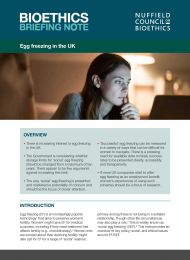Egg freezing in the UK
Policy Briefing
Published 30/09/2020

Women's experiences of egg freezing
Some describe EF – which has the same effects as IVF – as physically unpleasant, particularly the daily hormone injections that affect mood and create feelings of general anxiety. Available data on how women feel about their experiences of SEF suggest they feel frustrated with insufficient information on success rates to inform their decisions on SEF. They may also mourn not being able to pursue motherhood in a way considered ‘the norm’, and can feel isolated and stigmatised if they do not have a partner. However, a more positive common emotion after having SEF is one of relief. Other women report that SEF made them feel empowered and ‘in control’ of their reproductive future.
Success rates
There are limited data on pregnancies and live births from EF because of its relative newness as a fertility treatment, and the fact that only a small number of women who have frozen their eggs have returned to use them (see below). Clinics have been criticised for not providing easy access to data that are available, leading women to turn to the media for information instead.
Not all eggs survive thawing. If they do, the chance of live birth (LB) depends to a large extent on the age at which eggs are collected: broadly, the chances are higher for eggs frozen before 35. Furthermore, the older the woman, the more eggs needed to have a good chance of a LB. However, in the UK, the most common age for SEF is 38. If storage time limits increase, this might change. Success rates also vary with clinics’ experience and practitioners’ skills.
Frozen eggs from donors have higher success rates because they tend to be from younger women. If data include donor egg cycles, this should be made clear to avoid misinterpretation.

Share